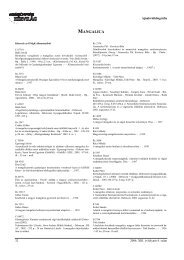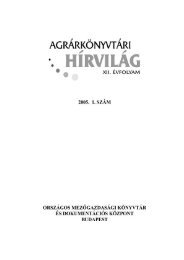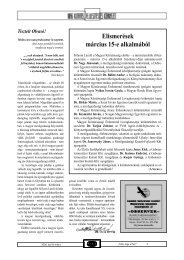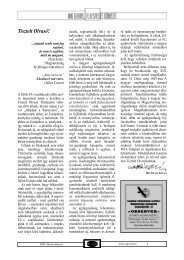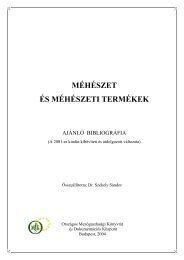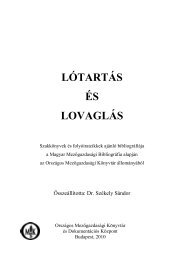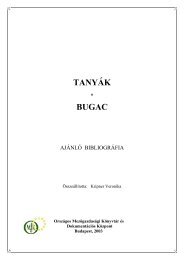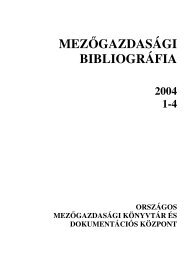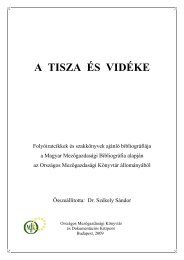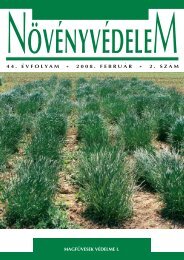hUNGARiAN AGRicUltURAl RESEARch
hUNGARiAN AGRicUltURAl RESEARch
hUNGARiAN AGRicUltURAl RESEARch
You also want an ePaper? Increase the reach of your titles
YUMPU automatically turns print PDFs into web optimized ePapers that Google loves.
Figure 6: Olasz rizling P.2/41<br />
candidate sub-clone<br />
Photo: János Werner<br />
ampelographic characterisation of<br />
variants and confirm that old<br />
Kadarka plantations were highly<br />
variable and contained varieties<br />
possibly originated from the<br />
Balkans (Olasz kadarka, Virághegyi<br />
kadarka, Török kadarka) as well as<br />
seedlings developed locally (Mészi<br />
kadarka), together giving the<br />
complex, uniquely full-flavoured<br />
and famous Kadarka wine.<br />
Olasz rizling<br />
The Olasz rizling cultivar, one<br />
of the most reliable varieties, is<br />
principally cultivated in Hungary<br />
and the neighbouring countries. Its<br />
selection began as long ago as in<br />
1951 in Pécs. The registered P.2<br />
clone is one of the most<br />
widespread clones in the country.<br />
In addition to other domestic and<br />
foreign clones, it is important to<br />
select variants that maintain the<br />
original quality of the P.2 clone<br />
but are able to accumulate more<br />
sugar, ripen earlier, less sensitive<br />
to bunch rot and have looser<br />
clusters and smaller berries. The<br />
selection programme was started<br />
by assessing the variability of an<br />
old plantation and a stock<br />
Figure 7: Hólyagos Furmint P.42<br />
Photo: János Werner<br />
originating from Fruska Gora<br />
(Republic of Serbia), an important<br />
production region of the variety<br />
for a long time past. Our<br />
observations revealed significant<br />
variability in the examined stock<br />
of the P.2 clone, and 75 parent<br />
vines were assigned for further<br />
trials (Figure 6) to analyse the<br />
correlations between yield, the<br />
sugar and acid content of must and<br />
the average weight of clusters.<br />
Significant variability was found<br />
in the population for most of the<br />
examined parameters. Among the<br />
vines evaluated, the quality<br />
parameters of 16 plants were<br />
significantly better than the stock<br />
average. The degree of must<br />
produced from the clusters of these<br />
plants exceeded the stock average<br />
by more than 1.0 Oeº, and the acid<br />
content of must was above 7.0 g/l<br />
(Table 5). Further valuable clones<br />
were discovered in the stock<br />
originating from Fruska Gora and<br />
the Institute’s gene bank as well.<br />
The P.10 clone of Cifra rizling,<br />
ripening 2–3 weeks earlier than the<br />
base variety, deserves special<br />
attention. The best vines were<br />
multiplied and multi location<br />
experiments were set up in<br />
different wine regions of the<br />
country (Mátraalja, Pannonhalma-<br />
Sokoróalja, Pécs, Somló, Tolna) to<br />
evaluate the performance of<br />
candidate sub-clones under<br />
various ecological conditions.<br />
Furmint<br />
Furmint, being dominant in<br />
Tokaj-hegyalja and Somló and<br />
cultivated also in the wine regions of<br />
Pécs and Villány, is one of the most<br />
important ‘Hungarica’ varieties. The<br />
quality or special quality wine<br />
produced from this variety is<br />
aromatic, a bit tartish and has high<br />
titratable acid content. Its yield is<br />
greatly influenced by the fertility of<br />
its flowers of different types or type<br />
variants. The base variety is<br />
genitally degraded, therefore,<br />
produces incomplete clusters. At<br />
present, clones of the variety (Kt.4.,<br />
P.14., P.26, P.27, P.51, T.85, T.92)<br />
are available for planting.<br />
The profound studying and<br />
selection of the Furmint variety<br />
group was started with the Változó<br />
and the Fehér varieties in 1950 in<br />
Pécs under the direction of Márton<br />
Németh, and as a result, numerous<br />
clones were developed from the<br />
sub varieties of the Változó and<br />
Fehér varieties (Table 6).<br />
Hungarian Agricultural Research 2009/3–4 29



